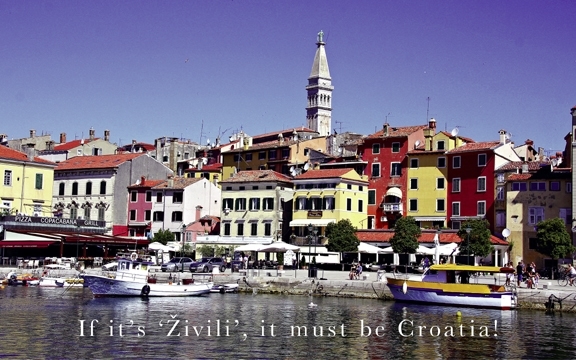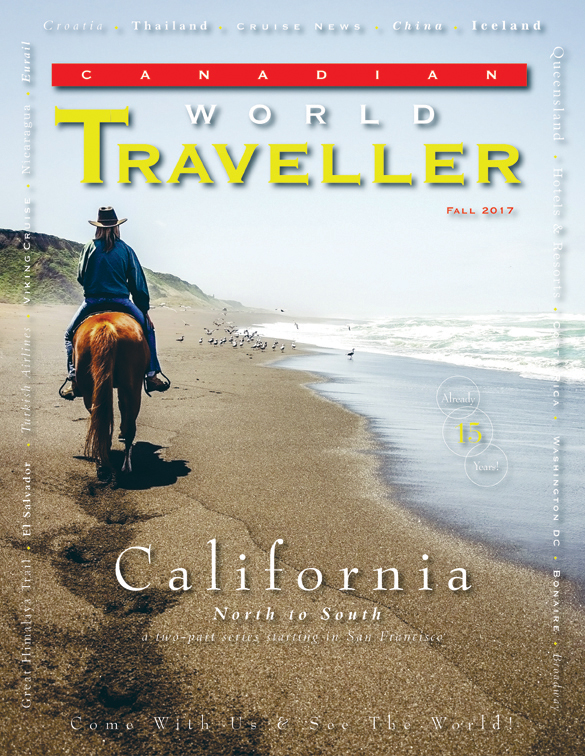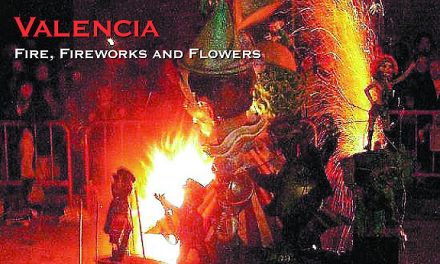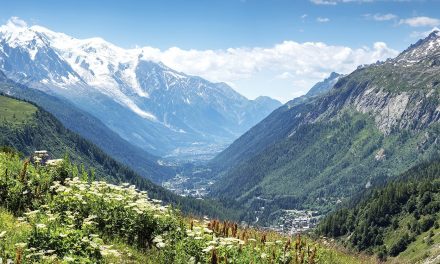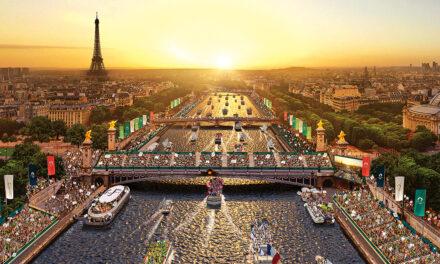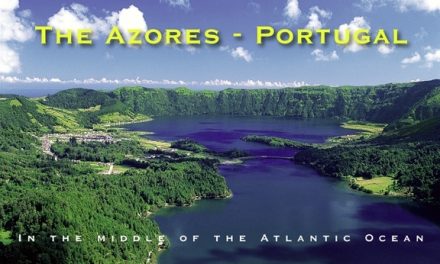Croatia
If it’s ‘Živili’, it must be Croatia!
Article and photography by Steve Gillick

In Croatia, you say “Živili” when you click glasses before drinking. It altruistically means “be filled with life” and in so many ways, this toast represents the exuberant Croatian travel experience: friendly people, great conversations, amazing sites, walkable cities, safety during all hours of the day and night, sunshine 300 days of the year, great food, wine and beer, and a ton of positive energy.
Over the course of our two week trip throughout the country, we had unbelievably great meals just about everywhere, and we were continually astounded by the service, the quality and preparation of the food and the genuine friendliness of the restaurant owners. In fact after a typical conversation, followed by an introduction to the owner’s family, we were inevitably offered a digestif: Grappa, Schnapps, Rakia or Maraschino and before we drank, we would all raise our glasses and say “Živili”.
But the idea of Živili goes one step further. In Dubrovnik, Ivan Vuković, our guide noted that he could always tell when tourist season was about to begin, as take-away coffees started to appear on the street. He explained that “Croatian people sit and drink coffee. They enjoy tasting the coffee and taking their time to enjoy it”. In Zadar, we spoke with Chef Marco Valković at the ultra-popular Pasta & Svasta (pasta and everything else) who echoed the sentiment that “we take our time, we just do the best we can and prepare our meals the old way. Customers willingly wait until it’s prepared properly”.
And with a strong Italian influence on just about everything in Croatia (most Croatians are fluent in Italian and English), even the pizzas are incredibly good. At Pizzeria Mizarola in the city of Hvar, Pizza reached a whole new dimension of taste. Marino Radojković, the owner, explained that “Mizarola’ referred to the barrels of water or wine, typically carried by donkeys. And only due to the power of suggestion, we immediately ordered some local white. First the seafood platter arrived with substantial portions of fish paté, fish carpaccio, octopus, arugula, tomatoes and black olives. Everything was so fresh. And then the pizza was served. We thought we had ordered a simple four-cheese pizza with anchovies, but it arrived with dollops of clotted cream, and local cheeses that were beyond absolutely delicious.
And it’s no coincidence that along the Adriatic coast the seafood is excellent. Whenever we had the opportunity to chat with restaurant owners, they inevitably revealed that they were also fishermen. In Rovinj, Zdravko Cvijetić, the owner of Konobo El-Niro, explained that “Konobo” referred to a place where food was prepared, with a specific emphasis on local food. He had caught most of the seafood on the menu that morning. (The grilled scampi were superb).
But it was our very first meal in Cavtat where Duro Vragolov, the owner of Konoba Kolona said that his father taught him to be a fisherman and while it was a challenging job, he loved bringing fresh seafood into his restaurant. He told us that ‘watching the moon descend into the sea” made him very happy, but equally so when the people in his restaurant tasted the seafood and responded with smiles”. Talk about Živili…be filled with life!
Cavtat was a great place to start our adventure. On one side of the Promenade there are old residential buildings, souvenir and ice cream shops, St. Nicholas Church dating from the 15th century, and outdoor cafés, while on the other side, small to palatial yachts are docked next to fishing and adventure cruises, and a fleet of water taxis taking visitors to and from Dubrovnik.
The next day we flew to Zagreb and then reached Pula by highway coach. We were greeted by a stunning red, yellow and orange sunset, peeking through the ancient archways of Pula’s Amphitheatre, right around the corner from our accommodation. In the old town, we wandered toward the Roman Forum where the remains of the Temples of Augustus and Diana sit in a large courtyard bustling with activity and just down the street, the Arch came into view.
Between the years 27 and 29 BCE, Salvia Sergia built an archway to honour her three brothers who had fought in the Battle of Actium, thus helping the Roman Republic defeat the combined armies of Mark Antony and Cleopatra. The “Triumphal” arch still stands in Pula and every evening, hundreds of locals and tourists stroll under the Arch, enjoying their ice cream, gelato, and Pula’s vibrant café culture.
Only 30 minutes away, Rovinj is another great town to explore. After walking the narrow, winding streets, we sat at a café by the morning market, drinking cold mugs of Karlovačko Beer and watching the busy market vendors. As this was Sunday, Church bells were resonating throughout the picturesque town of sea-side restaurants, residences, art galleries and small rocky beaches.
The scenery changed again in the old city of Zadar. The Square of the Five Wells, the Lion Gate, the 9th century Church of St. Donatus and the Roman Forum are all must-sees, and then at dusk the crowds gather on the marble steps of the Promenade, to watch the sun set and listen to the water!
Inspired by the role that water played in the origin and growth of cities, Architect Nicola Bašić constructed the Sea Organ to re-connect people with the water. Waves push through a series of pipes and cavities under the marble steps and produce mystical sounds.
In sharp contrast, the Promenade in Split is teeming with tourists, chatting in cafés, shopping for souvenirs or wandering with suitcases-on-wheels to and from the nearby ferry dock or bus station. The city’s main attraction, Diocletian’s Palace dating to 305 CE, sees hundreds of tour groups traipsing after their guides.
We discovered that the early morning was a cooler and quieter time to explore and take photos and when the groups started to arrive, we escaped to the town of Trogir. Here, smiling, friendly market vendors offered samples of home-made prosciutto and olive oil. In the UNESCO World Heritage-designated old city, the stunning stone carvings on the Cathedral of St. Lawrence, as well as the scenery from the bell tower, were postcard perfect. And outside the city walls the ramparts of the 15th century Kamerlengo Fortress provided more great views of the city and the sea.
The Island of Hvar is one of Croatia’s most popular destinations and after arriving by Ferry from Split, we climbed a flight of 79 steep, stone steps, to our accommodation. However, just a short distance higher, was the Fortress Spanjola, where spectacular views are commonplace.
Hvar is very picturesque walking town that appeals to both party goers as well as those looking to chill out. On the other side of the island there is a 45 minute walk from the tiny town of Jelsa, along the coast, to the equally tiny town of Vrboska. And along the way there is nothing but blue waters, rocky beaches, lush green trees and a few vacation homes.
One hour away on the island of Korcula, the Cathedral of St. Mark as well as the Town Museum and the Bishop’s Treasury are definitely worth visiting. Just outside the city walls, the Marco Polo souvenir shops, the Marco Polo Museum and Marco Polo’s House, identify Korcula as the birthplace of the great explorer when it was part of the Venetian Empire.
In the town of Lumbarda we walked through vineyards and tasted the locally produced wines: GRK (pronounced “gerk”) and Plavic (“plavich”). Bottles of each ended up in our take-home luggage.
And finally after two weeks, we arrived in Dubrovnik and met Ivan for an introductory tour. The area outside the Pila Gate, which is the main entrance to the walled city, was packed with tourists, tour groups and die-hard Game of Thrones fans. The city itself sees history oozing out of every building in every public square. With photographers brandishing selfie-sticks and crowding around St. Mary’s Cathedral, the Rectors Place, the Clock Tower, the fountains and more, it’s a very energetic place to explore. One of the highlights is the 90-minute walk on the city walls, where at dusk the sunlight shines magical colours on the buildings throughout the city.
Our last night included an unbelievably tasty dinner at Konobo Bonaca in the town of Sustjepan: Seafood Salad, grilled squid and Scampi and a great bottle of local Merlot. Ivan Kapetanić the owner, explained that “Bonaca” (pronounced “Bonatsa”) described the calm, quiet state of the sea—perfect weather conditions for a fisherman. And it also seemed to describe so much of what we had seen and done in Croatia: the people we met, the conversations we had, the food, the attractions– all had amounted to perfect conditions for travel.
And when Ivan brought two glasses of Grappa ‘for service’, we toasted him and his family with “Živili”—“be filled with life”. It was a perfect ending to our holiday in Croatia and a very sincere way of saying “Thank you…we’ll be back”.
www.visitcroatia.com
Click on cover to view published article

